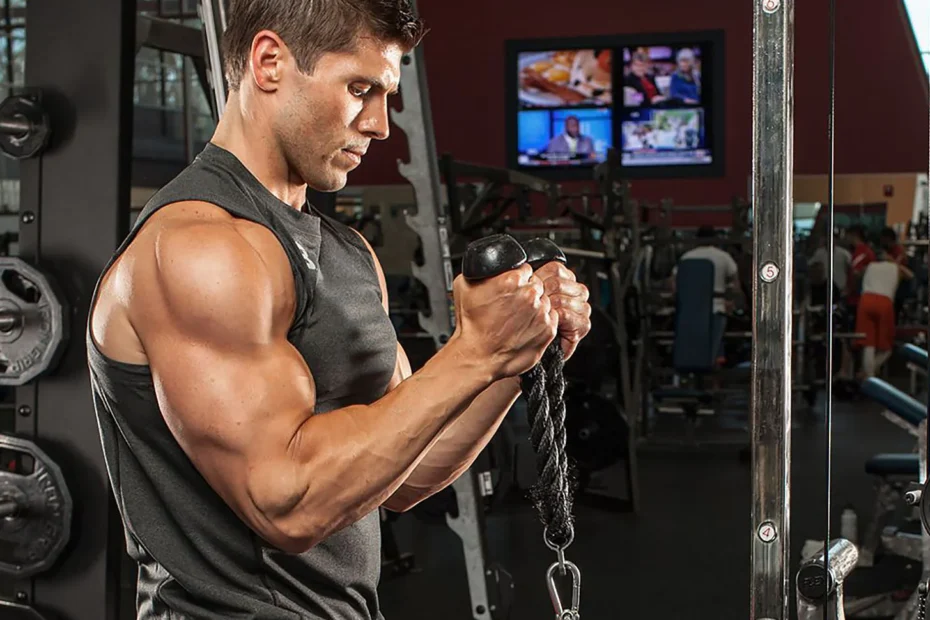Cable hammer curls are a valuable bicep exercise that targets both the biceps brachii and the brachialis, helping to create a well-rounded and aesthetically pleasing upper arm. This exercise is performed using a cable machine with a rope attachment or a straight bar handle. In this article, we will explore the cable hammer curl exercise, including the muscles worked, how to perform it correctly, benefits, common mistakes to avoid, variations, and alternative exercises.
Muscles Worked
Before diving into the details of the cable hammer curl exercise, let’s understand the primary and secondary muscles worked during this movement:
Primary Muscle Targeted:
- Biceps Brachii
Secondary Muscles Engaged:
- Brachialis (a muscle beneath the biceps)
- Brachioradialis (a forearm muscle)
- Forearm flexors (during grip and wrist stabilization)
How to Do Cable Hammer Curls
Follow these steps to perform cable hammer curls correctly:
Equipment Needed: Cable machine with a rope attachment or straight bar handle.
- Set Up:
- Attach the rope attachment or straight bar handle to the low pulley of the cable machine.
- Adjust the weight stack to your desired resistance.
- Grip:
- Grasp the rope or bar handle with a neutral (hammer) grip, which means your palms are facing each other.
- Stand facing the cable machine, with your feet shoulder-width apart.
- Starting Position:
- Stand up straight with your chest up and shoulders back.
- Keep your elbows close to your sides and fully extend your arms, allowing them to hang naturally.
- Execution:
- Inhale and curl the rope or bar handle upwards by flexing your elbows. Keep your upper arms stationary throughout the movement.
- Squeeze your biceps at the top of the movement to maximize muscle contraction.
- Top Position:
- At the top of the movement, your forearms should be close to perpendicular to the ground, with your biceps fully contracted.
- Hold this contraction briefly.
- Lowering the Weight:
- Slowly lower the rope or bar handle back to the starting position, extending your elbows.
- Maintain control during the descent to maximize muscle engagement.
- Repetitions:
- Aim for 8-12 repetitions per set.
- Sets:
- Perform 3-4 sets of cable hammer curls, resting for 1-2 minutes between sets.
Benefits of Cable Hammer Curls
Cable hammer curls offer several benefits for your biceps and forearm development:
- Bicep and Brachialis Emphasis: Hammer curls target both the biceps brachii and the brachialis, promoting well-rounded upper arm development.
- Forearm Engagement: This exercise also engages the brachioradialis and forearm flexors, enhancing forearm strength and grip.
- Variety of Grips: You can use different grip attachments, such as ropes or straight bars, to target the biceps and forearms from various angles.
- Continuous Tension: The cable machine provides continuous tension on the biceps and forearms throughout the entire range of motion, maximizing muscle engagement.
Common Mistakes to Avoid
To maximize the effectiveness of cable hammer curls and reduce the risk of injury, be mindful of these common mistakes:
- Using Excessive Weight: Start with a weight that allows you to maintain proper form and control. Using too much weight can lead to poor technique and strain on the elbows.
- Swinging or Cheating: Avoid using momentum to lift the weight. Focus on a controlled and deliberate movement.
- Losing Form: Keep your elbows close to your sides and avoid allowing them to flare out during the curl.
- Incomplete Range of Motion: Ensure that you fully extend your arms during the descent to maximize muscle engagement.
Variations of Cable Hammer Curls
To add variety to your bicep and forearm workout, consider these cable hammer curl variations:
- Single-Arm Cable Hammer Curl: Perform the exercise one arm at a time to isolate each bicep and forearm individually.
- Reverse Grip Cable Curl: Use a reverse (palms-down) grip on the rope or bar handle to emphasize the brachioradialis and forearms.
Alternative Bicep and Forearm Exercises
If you’re looking to diversify your bicep and forearm workout, consider these alternative exercises:
- Dumbbell Hammer Curl: Similar to cable hammer curls but using dumbbells, allowing for a full range of motion.
- Wrist Curls: These exercises specifically target the forearm flexors and wrist muscles, helping to improve grip strength.
Incorporate cable hammer curls into your upper body training routine to enhance your bicep and forearm development. Remember to use proper form, gradually increase the weight, and maintain consistency in your workouts to see the best results.
